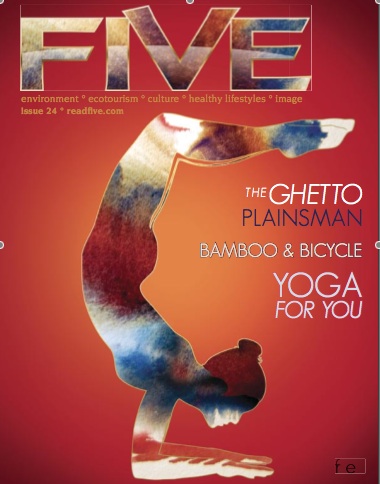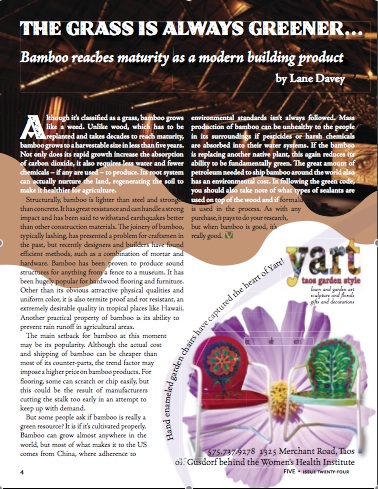
  |
The Grass is always Greener iss#24
Grass is Green and so is Bamboo
by Lane Davey
One new way to go green may be to replace wood with weeds. Since bamboo is classified as a grass rather than a tree, you might say its most enticing quality is that it grows like a weed. Unlike wood which has to be replanted and takes decades to reach maturity, bamboo grows from the same plant every five years. Not only does its rapid growth increase the absorbtion of carbon dioxide which is thought to be a key factor in global warming, but it also requires less water and less pesticides to produce. Its root system can actually nurture the land, regenerating the soil to make it healthier for agriculture.
Structurally, it is lighter than steel and stronger than concrete. It has great resistance which means it can handle a strong impact and has been said to withstand earthquakes better than other materials. The joinery of bamboo has presented a problem for craftsmen in the past, but in recent times they have found efficient methods for its construction. Bamboo has been proven to produce sound structures for anything from a fence to a museum. It has been hugely popular for hardwood flooring and furniture. Other than its obvious attractive physical qualities and uniform color it is also termite proof and rot resistant, an extremely desirable quality in tropical places like Hawaii. Another practical property of bamboo is its adaptivity to water which has even been shown to prevent rain runoff in agricultural areas.
The main setback for bamboo at this moment may be its popularity. Although the actual cost and shipping of bamboo can be cheaper than most of its counter-parts, the trend factor may impose a higher price on bamboo products. For flooring, I have heard that bamboo can scratch or chip easy, but this could quite possibly be the result of manufacturers cutting the stalk too early. In an attempt to keep up with the high demand, manufacturers are in turn delivering a poorer quality product. In an article titled "Is bamboo really green" architectural designer Erika Zekos makes the statement that “If you want to truly go green, you’ve got to go local, too.” Bamboo can grow almost anywhere in the world, but most of it comes from China. When products are produced abroad we do not know if they are keeping up with our U.S. environmental standards. Mass production of bamboo can be unhealthy to the people in its surroundings if pesticides or harsh chemicals are absorbed into their water systems. If the bamboo is replacing another native plant, this again reduces its ability to be fundamentally green and then there is of course the added use of petroleum to get it shipped from other areas to the us. In following the green code, you should also take note of what types of sealants are used on top of the wood and if formaldahyded is used in the process.
Ambient Bamboo Products, Cali bamboo and Northwest Bamboo are just to name a few of the companies you can check out here in the U.S. You can also look at these resources online:
Is bamboo really Green? February 16, 2008 by suehawks
http://spiritualdeepdish.wordpress.com/2008/02/16/is-bamboo-flooring-really-green/
Use of Eco-friendly bamboo products on the rise By Rick Johnson | Published 05/18/2006
http://www.ezilon.com/articles/articles/1500/1/Use-Of-Eco-Friendly-Bamboo-Products-On-The-Rise
Boom in bamboo buildings has green benefits
http://www.msnbc.msn.com/id/23237000/from/id/22934387/